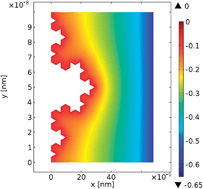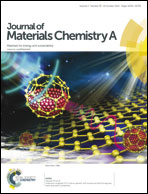Effect of fractal silver electrodes on charge collection and light distribution in semiconducting organic polymer films†
Abstract
Living organisms use fractal structures to optimize material and energy transport across regions of differing size scales. Here we test the effect of fractal silver electrodes on light distribution and charge collection in organic semiconducting polymer films made of P3HT and PCBM. The semiconducting polymers were deposited onto electrochemically grown fractal silver structures (5000 nm × 500 nm; fractal dimension of 1.71) with PEDOT:PSS as hole-selective interlayer. The fractal silver electrodes appear black due to increased horizontal light scattering, which is shown to improve light absorption in the polymer. According to surface photovoltage spectroscopy, fractal silver electrodes outperform the flat electrodes when the BHJ film thickness is large (>400 nm, 0.4 V photovoltage). Photocurrents of up to 200 microamperes cm−2 are generated from the bulk heterojunction (BHJ) photoelectrodes under 435 nm LED (10–20 mW cm−2) illumination in acetonitrile solution containing 0.005 M ferrocenium hexafluorophosphate as the electron acceptor. The low IPCE values (0.3–0.7%) are due to slow electron transfer to ferrocenium ion and due to shunting along the large metal–polymer interface. Overall, this work provides an initial assessment of the potential of fractal electrodes for organic photovoltaic cells.


 Please wait while we load your content...
Please wait while we load your content...